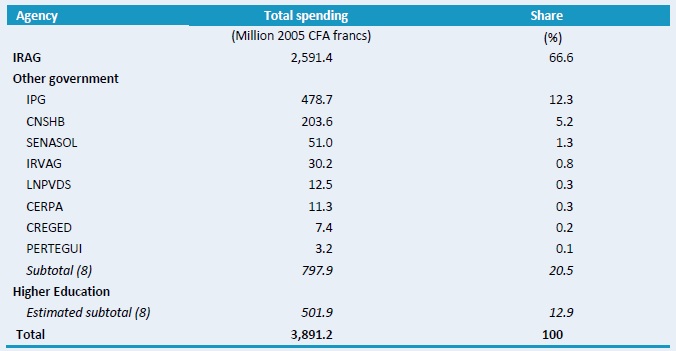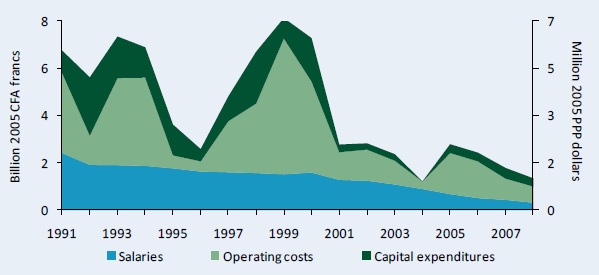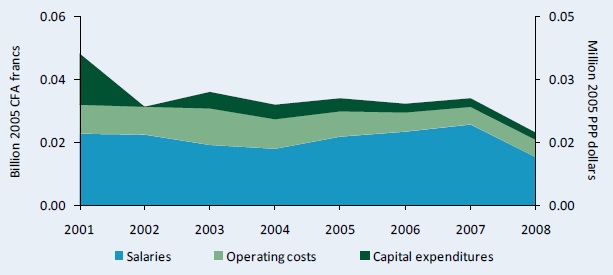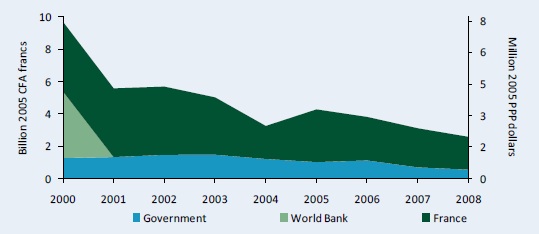The ASTI Data in Focus series provides additional background data in support of the 2010 Country Note on Guinea ( asti.cgiar.org/pdf/Guinea-Note.pdf) prepared by the Agricultural Science and Technology Indicators (ASTI) initiative and the Guinean Agricultural Research Institute (IRAG). Based on data collected by ASTI and IRAG, these two outputs review major investment and capacity trends in Guinea's public agricultural research and development (R&D) since 1991, providing important updates on agricultural R&D trends prepared by ASTI and IRAG in 2003–04.
B. Financial Resources
This section provides detailed quantitative information on expenditures in Guinean public agricultural R&D for the period 1991–2008. Complementary sections present detailed data on long-term trends (Section A), human resources (Section C), and research allocation (Section D). Other supporting information provides macroeconomic trends, a list of agencies included in the study, data sources and estimation procedures, and ASTI's methodology.
Table B1–Total spending levels in million 2005 CFA francs at various agencies, 2008
In 2008, the Guinean Agricultural Research Institute (IRAG) accounted for the largest share of expenditures of any single agency, at 2.6 billion CFA francs, and the Institut Pasteur de Guinée (IPG) ranked second, reporting expenditures of 0.5 billion CFA francs (in 2005 prices).

Notes: Figures in parentheses indicate the number of agencies in each category. Expenditures for the eight higher education agencies were estimated. For more information on coverage and estimation procedures, see the Guinea's country page on ASTI's website at asti.cgiar.org/guinea/datacoverage. For full agency names see asti.cgiar.org/guinea/agencies.
Figure B1–IRAG's spending by cost category, adjusted for inflation, 1991–2008
IRAG's salaries failed to keep pace with the high inflation rates in 2008. As a result, real spending on salaries at IRAG declined during 1991–2008. In addition, operating costs and capital expenditures fluctuated significantly in response to the completion of the National Agricultural Services Project (NASP) in 2000, financed through a World Bank loan. In 2008, IRAG spent 0.3 billion CFA francs or 0.3 million PPP dollars on salaries, 0.7 billion CFA francs or 0.6 million PPP dollars on operating costs, and 0.3 billion CFA francs or 0.3 million PPP dollars on capital investments (in 2005 prices).

Sources: Calculated by authors from IFPRI–IRAG 2009 and Stads and Béavogui 2003.
Notes: Salaries exclude those of expatriate staff that were active at IRAG during the entire period. For more information on coverage and estimation procedures, see asti.cgiar.org/guinea/datacoverage htt://asti.cgiar.org/niger/datacoverage].
Figure B2–Distribution of spending at IRAG and other government agencies by cost category, 2001–08
This figure presents data on average spending by cost category for IRAG and three other government agencies. Salaries accounted for about half or more of IRAG's expenditures until 2005, when operating costs began to account for between 50 and 65 percent of IRAG's expenditures from 2005 onwards.

Sources: Calculated by authors from IFPRI–IRAG 2009 and Stads and Béavogui 2003.
Notes: LNPVDS, PERTEGUIE, and CREGED were the only other government agencies for which data were available during this period. For more information on coverage and estimation procedures, see asti.cgiar.org/guinea/datacoverage.
Figure B3–IRAG's funding sources adjusted for inflation, 2000–08
IRAG receives funding from a few sources only. During 2000–08, government funding remained relatively stable but was only sufficient to cover researcher salaries and a portion of the operating costs. Consequently, IRAG remained highly dependent on supplementary funding from donors. Following the completion of NASP in 2000, funding from the World Bank ceased; however, IRAG continued to receive considerable funding from the French government. In 2008, IRAG received 0.6 billion CFA francs or 0.5 million PPP dollars from the national government, and 2.0 billion CFA francs or 1.7 million PPP dollars from the French government.

Sources: Calculated by authors from IFPRI–IRAG 2009 and Stads and Béavogui 2003.
Notes: Data include donor funding from the World Bank and France. The exact amounts received from other donors were unknown and hence had to be excluded. Donor funding from France includes the salaries of expatriate CIRAD staff employed at IRAG.
Copyright (C) 2011 International Food Policy Research Institute (IFPRI) and Guinean Agricultural Research Institute (IRAG). Sections of this Data in Focus issue may be reproduced without the express permission of, but with acknowledgement to IFPRI and IRAG. This series is an output of the ASTI initiative and has not been peer reviewed. Any opinions stated herein are those of ASTI and do not necessarily reflect the policies and opinions of IFPRI or IRAG.
